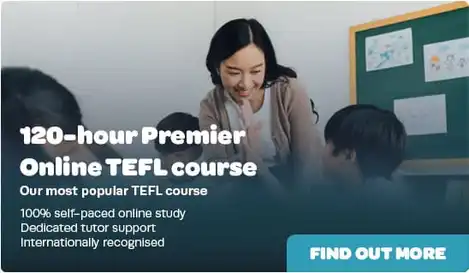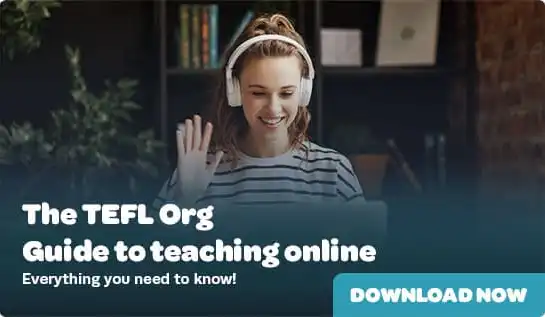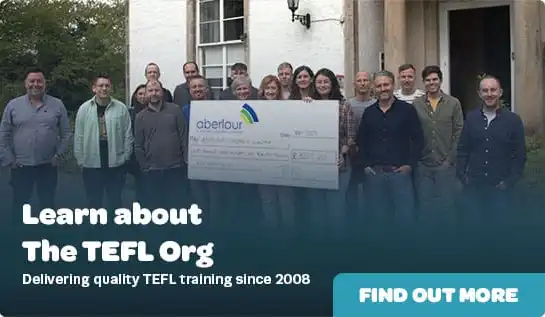- TEFL Courses TEFL Courses
- View all TEFL courses
- 120-hour Premier Online TEFL Course
- 200-hour Level-5 Online TEFL Course
- Online TEFL Courses
- Classroom TEFL Courses
- Combined TEFL Courses
- Virtual TEFL Courses
- TEFL Course Bundles NEW
- Advanced TEFL Courses
- TEFL Lesson Plans & Resources
- TEFL Gift Vouchers
- Which TEFL course is right for you?

- New to TEFL New to TEFL
- Locations
- TEFL Jobs
- Teach Abroad Teach Abroad
- Teach English Abroad
- Teach English in Japan
- Teach English in South Korea
- Teach English in Spain
- Teach English in China
- TEFL Salaries Abroad
- Requirements for teaching abroad
- Teach English abroad without a degree
- How to find teaching jobs abroad without experience
- Can you teach English abroad as a non-native speaker?

- Teach Online
- About Us
- Blog
- Podcast
How to Teach English to Beginners
Teaching English to beginners can be challenging, but there’s nothing quite like seeing a learner’s journey.


TEFL course provider
TEFL certificate
teachers trained
find work within 2 months
When you’re navigating the English teaching world, you’re going to work with all kinds of people. Young people, adults, older adults, and everyone in between will be looking to you for instruction in English for all sorts of reasons.
Whether it’s for work, to make friends, travel or even for romance (believe us, it’s a big motivator), there are a vast array of reasons people pick up English. Of course, there’s also a sizeable worldwide contingent of school pupils who have to learn English as part of their daily lessons.
What everyone has in common, whatever their reason or age, is that they have to start somewhere. Teaching English to beginners is something that you might well do at some point in your TEFL career, and we’re talking about people who can barely speak a word of English.
So, how’s it done? What do we even mean when we say a “beginner”, and what kinds of lessons are most important for new English learners?
Teaching English to beginners: an overview
When we talk about ESL students being beginners, what do we mean by that?
The popular Common European Framework of Reference (CEFR) scale measures English proficiency. In terms of a “beginner” and their level of English proficiency, someone at the first level - A1 - should be able to:
- Comprehend and use familiar everyday expressions and fundamental phrases
- Introduce themselves and others, and ask and answer questions about personal details, including where they live, people they know, and things they have.
- “...interact with other people in a simple way provided the other person talks slowly and clearly and is prepared to help.”
However, if you’re teaching kindergarten school children who aren’t native English speakers, your beginner students will likely be less advanced than this. Teaching the English alphabet and the sounds of each letter can be understood as the most fundamental “beginner” exercise.
Why teach beginners? Teaching English to beginners sounds stressful and, in some ways, more labour-intensive than teaching other types of learners. However, the rewards are incredible. Seeing someone with zero idea how to read, write or speak English eventually be able to blossom into even a rudimentary English speaker, and use the language to their advantage, is a genuinely unique teaching experience.
Teaching English to beginners can be frustrating, and teaching beginners isn't for every ESL teacher. However, laying the foundation for someone to understand a language spoken by 1.35 billion people is powerful!


Understanding your learners' needs
Let’s examine how to teach beginner English. The first step is understanding what your learners need from you, what kind of education they’ve had, and what language skills they have.
If you’re teaching a young learner, for example, their language skills in their native language will be pretty basic. They won’t have had an extensive education, and their best learning experience might come in the form of crafts, songs and other interactive activities.
However, teaching teenagers and adult learners is very different. Suppose they have advanced language skills in their native tongue and are looking to add English to their linguistic repertoire. In that case, you can reference the differences between languages, use translation exercises, and exclusively use materials suited to their age and experience.
In any case, it’s important to identify learning styles and preferences with any age group. Some learners will prefer to learn through different techniques. If you’re teaching a class of beginners, it’s more difficult to tailor the experience, so try to involve your students in group activities and interactive, engaging materials. With individual learners, you can more efficiently meet their specific needs and find out what materials they want to use to learn. This can include music, film, podcasts, and other forms of media.
Starting with the basics: vocabulary and pronunciation
Your students probably know something in English. Even if it’s just “hello” or “I am”. These are the basic building blocks that are fundamental to learning everything else.
Once you've mastered the alphabet, teaching essential vocabulary words and phrases is a great launching pad for success. Immediately, you can contextualise the shapes of the letters, how they correspond to sounds, and how the letters shape around each other.
“Hello”, for example, is a great way to introduce vowel sounds, a “ll” sound, and tone. “Hello” is said in a certain way, typically with an open, friendly manner behind it. You can do an entire lesson on “hello”, let alone other greetings. Nailing the pronunciation and intonation can unlock loads of different sounds and phrases.
“Hello, I am…” is a more advanced lesson that introduces loads more concepts. Your beginner can introduce themselves in English by giving their name. “I am” is a key phrase that will be fundamental to their experience of speaking the language. Next time, you can add an emotion, “...and I am excited to meet you,” for example. The possibilities are endless!
These are the kinds of basic lessons that can excite beginner learners. Fundamentally, people learn a language to use it, after all! Repeating these greetings and introductions will help your learners get to grips with pronunciation, sounds, word placement, and so much more.


Teaching basic grammar in a simple way
Grammar is important. It’s the difference between knowing some words and knowing how to understand and articulate yourself in a language. However, teaching English grammar to beginners can be tricky, just as it can be challenging to learn.
So, it’s all about keeping things simple and concise. Don’t overload yourself and your learners with a million examples; instead, focus on one or two techniques and examples that you like and that learners respond to. Ask your students handy phrases "How are you?" or "Did you do your homework?". These may seem like simple questions, but they involve using different tenses.
Use simple language with plenty of gestures and visuals to give lots of clues as to what you are saying. It’s critical not to make things too complicated or use language that’s overly casual, as students can feel demotivated and lose confidence.
Teaching tenses with grids and tables is a tried and trusted method, and it’s simple to understand. Think “was/is/will” and “drank/drink”—using simple tables to describe the differences between tenses is straightforward.
Try some of these online grammar resources to help with your lessons.
Using visual aids and gestures
Visual prompts and gestures are handy tools regardless of your learners' age. Of course, it’s crucial to keep your materials relevant to your age group - you don’t want to alienate any adults who start learning English later on - but in the spirit of keeping things basic, visual aids can be super helpful.
Pictures, flashcards and diagrams are a great way to go. You'll need pictures when you’re teaching the absolute fundamentals, like the alphabet. Flashcards can be used for interactive games when you’re teaching tenses, like “is/was” and so on. Diagrams help illustrate the differences between tenses or conditional sentences. It’s your choice how you use these tools. You’re the English teacher!
Gestures and body language are incredibly helpful for conveying tone and meaning. We discussed the power of “hello, I am…” and using your hands to express actions is important here. Visual cues will help learners build bridges between words and actions and can help develop vocabulary retention.
Physical activities and games are a fun way to keep students engaged. Passing a ball around may sound rudimentary, but if each person has to say a fundamental phrase in English when they catch the ball, it forces quick thinking and creativity. It’s all about making things memorable and fun.


Speaking and listening skills
One of the biggest and most important challenges when teaching English is getting people talking. Let’s be clear: you want a busy, noisy classroom full of enthusiastic English speakers!
How do you foster this environment? Well, you’ve got to create opportunities for students to communicate. Teaching English abroad in a busy classroom differs significantly from teaching English online one-to-one, but the principles are the same.
Organise opportunities for students to practice with each other. Again, if you teach abroad and have a full classroom, you can split classes into small groups where beginners can talk to each other in basic English phrases. If you’re teaching one-to-one, ask your student to repeat phrases after you, or better, try to articulate something of their own volition, using vocabulary you’ve taught them.
When you’re trying to introduce more and more vocabulary into the class, use topics familiar to your students. Modes of transport, sports, what your students had for lunch - the very basic English they’ll need at the very start of their English journey. Slowly, you can turn these conversations into role-play scenarios, where active listening will be as important as what’s being said. Your students will start to have conversations and respond to what’s being said instead of just saying the basic phrases they know.
Building reading and writing skills
The importance of reading and writing might seem obvious, but for anyone needing a refresher, reading and writing are fundamental skills for English language proficiency and a range of other crucial life skills. Even if you teach English to adult learners, don’t take it for granted that you’re teaching someone who can read and write.
If you are teaching English to beginners who need help to read or write in the language, start slowly. Read to your students, and don’t be afraid to use books: simplified, age-appropriate and level-appropriate texts. Story time with your students, where pupils take turns reading aloud, is a fantastic way to improve reading comprehension and pronunciation. Be patient with your students, and help them read the more difficult words and phrases where needed.
When it comes to writing, start easy and slowly, then build it up. Simple sentences (we can go back, once again, to “hello, I am…” and work from there) are crucial building blocks that inform the rest of a beginner’s learning experiences. Sounding out the letters and words as they’re written is also good practice!
As you ramp up the proficiency, you can assign more advanced exercises. For example, when you were at school, you might remember being asked to write about what you did at the weekend. That wasn’t for no reason. That’s an excellent way to practice writing in the past tense, using more extensive vocabulary, using pronouns, adjectives, verbs and adverbs, and building English language skills more broadly. Teaching English to beginners is a fun opportunity to set the tasks that you once did!

Creating a positive learning environment
Finally, but perhaps most crucially, it’s vital to foster a supportive, positive learning environment when you’re teaching beginners. What was it like when you were taught English? Did you feel happy and engaged in that space?
Knowing your students and how quickly they can learn is really important. When you take a TEFL course, you’ll learn that everyone cannot be taught English at the same pace. Some learners will struggle with things others find easy, and vice versa. When teaching beginners, it’s imperative to ensure your praise isn’t going too far in one direction, and your patience isn’t limited.
Recognising your students’ work is essential. Keeping your beginner learners motivated is such a big part of the experience. Without your support, constructive feedback, and encouragement, your learners will not progress, and you will struggle to teach English to a group of unmotivated learners. When your learners achieve something, like learning the alphabet, saying where they live, using the past tense correctly for the first time, or reaching some other significant milestone, it’s worth celebrating together.
The environment you establish as an English teacher is critical to a learner’s success. You want your students to associate the English language with positivity. That way, they’ll learn the language and have a lot of fun doing it. Perhaps that’s the most important lesson for anyone who wants to know how to teach English to beginners!
More on how to teach English
Frequently Asked Questions
Q. What is the best way to start teaching English to beginners?
When you start teaching English to beginners, keep it simple. Basic phrases, repetition of the alphabet and simple back-and-forth introductions are excellent stepping stones.
Q. How do I teach English pronunciation to beginners?
Teaching English pronunciation to beginners can be done in myriad ways. The best methods to teach pronunciation are using different media forms, like films, reading books aloud, and podcasts. This way, beginner learners can hear English speakers pronouncing words naturally.
Q. What are the basic things to teach English?
When teaching English to beginners, it's crucial to get the basics right. Reading, writing, speaking, and listening are the most crucial skills to teach learners.
Q. How do I teach English grammar to beginners?
There are loads of great ways to teach English grammar to beginners. Some English teachers like using the Presentation, Practice, Production (PPP) technique, which is particularly useful for teaching conditionals. Teaching tenses with tables and diagrams is a simple method that gets the point across well.










